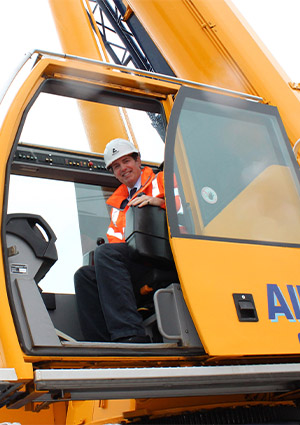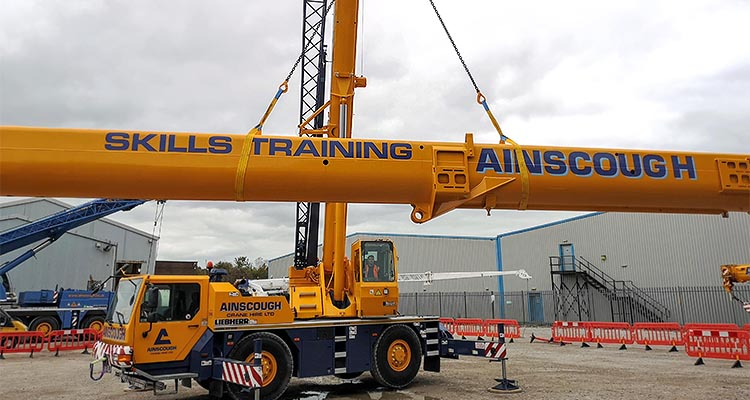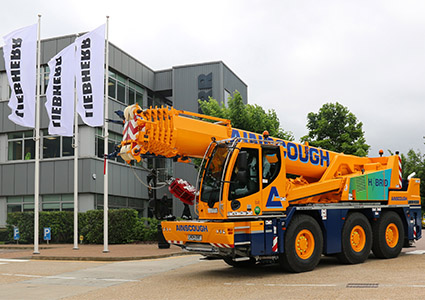Discover how Ainscough Crane Hire is leading the way in the mobile crane hire industry
With approaching 400 cranes at its disposal, Ainscough Crane Hire (Ainscough) has the largest and most diverse fleet in the construction industry. This makes it perfectly equipped to deliver a tailored service to meet the specific needs of each customer. Operating from 25 locations across the UK, the company’s dedicated team of experts is passionate about delivering projects on time, to budget and most importantly, to the highest possible safety standards. Indeed, safety is a core part of Ainscough’s industry recognised ‘make the safe choice’ ethos and underpins every single aspect of its operations, from contract lifts and crane hire to specialist projects for customers. We sit with Peter Gibbs, CEO, for an informative discussion on the company’s background and evolution.
 “Widely recognised as a lifting services business, Ainscough is primarily a mobile crane hire company established in Wigan by the Ainscough family nearly 50 years ago. Throughout its history, it has experienced tremendous growth through acquisitions, eventually becoming the only truly national mobile crane business in the UK, as well as the leader in safety and service innovation. When the Ainscough family first created the business, they developed many initiatives which are still ongoing, from engineered safety solutions on the cranes to training its staff as technical managers to support lifting planning. Presently, Ainscough is three-to-four times larger than the next biggest player in the marketplace,” he affirms.
“Widely recognised as a lifting services business, Ainscough is primarily a mobile crane hire company established in Wigan by the Ainscough family nearly 50 years ago. Throughout its history, it has experienced tremendous growth through acquisitions, eventually becoming the only truly national mobile crane business in the UK, as well as the leader in safety and service innovation. When the Ainscough family first created the business, they developed many initiatives which are still ongoing, from engineered safety solutions on the cranes to training its staff as technical managers to support lifting planning. Presently, Ainscough is three-to-four times larger than the next biggest player in the marketplace,” he affirms.
Managing complex lifts
Peter expands on the current range of services offered by Ainscough. “Our basic service is crane hire, for which we provide a crane with an operator to a customer. This service is only available for customers who have the expertise required to supervise the job, thus ensuring that it is carried out safely. Where appropriate, we offer contract lifting services, in which we send a technical manager before the job to plan and prepare for the lift. This includes checking the ground conditions, where the crane will be positioned, and ensuring that the lift is carried out safely under our direct control and supervision. We also undertake more complex planning services for projects requiring larger cranes, which typically need support from multiple trucks and smaller cranes to help rig the main crane. The lifting side of our operations can be particularly complex, due to factors like site access, ground conditions, physical obstacles, and the object being lifted. Nevertheless, we can handle even the most complex lifts. For example, Ainscough cranes are currently being used for bridge and gantry works that require a number of weekend closures of the M25 at junction ten; this requires multiple cranes, trucks, operators, engineers, pre-servicing, and management support. On such an important project, no delays can be afforded, so our fleet depth, expertise, and planning were relied on to avoid any potential problems.”
To stay ahead of the competition, Ainscough prioritises innovation – especially when it comes to safety. “Innovation has always been our forte. We pioneered the Contract Lift Manager role in the 1970s, which is now standard around the world. Our fleet is entirely comprised of high-quality Liebherr cranes. We argue that the best crane in the world is the Ainscough specification of Liebherr crane. All cranes in our fleet must meet our stringent specifications, which include the highest level of safety features. We place a strong emphasis on equipment safety; this creates a substantial point of difference from most our competitors because the crane industry is largely unregulated and is exempt from the operating licence requirements that apply to all heavy goods vehicles (HGVs). I chair the Crane Industry Group, which represents the best interests of all mobile crane operators, and am actively working to remove this exemption to raise the level and consistency of safety standards across the industry. Our commitment to safety innovation is evident through a range of engineered safety initiatives, such as our handbrake and boom alarms, the redesign of our hydraulic wiring, and the Ainscough designed safe access tackle box on the rear of our cranes. We equally put a lot of effort into our training and use of technology to support safety and operational efficiency, such as supporting carrying out walkarounds checks and using What3words to precisely geolocate our cranes,” Peter enlightens.
Technology in action 
Continuing this tangent, Peter tells us more about the role of technology in the business. “In 2019, we implemented a new IT system, which is now fully embedded and is providing significantly enhanced visibility, real time interaction with our operators, as well as enabling better informed decision-making. Moreover, the new system allows us to see what each of our cranes and operators is doing, what is working efficiently, and where we can in turn deliver improved utilisation to benefit both our customers and ourselves. Fundamentally our IT and AI developments have enabled a step change in remote operator engagement, interaction between lift planning and execution, and wider safety and servicing, giving us the opportunity to use live and interactive handheld devices linked to the lift plan and crane, along with QR codes and picture-taking to stay on top of servicing so that the operator and equipment can safely travel around the country and be remote for some time. Lastly, our new IT system provides us with tracking information on aspects like driving style, which further supports efficiency and safety.
“Technology is also helping us make a step change with wider operator engagement and aspects of refresher training. We conduct more training than the rest of the industry combined; this is required to support the extensive network we have across the UK and keep on top of sector specific training such as National Grid. Furthermore, our cranes benefit from technological advancements, such as stage V engines and improved engine control units. For instance, mid-size cranes that historically used two separate engines for lifting and travel can now be run off a single, much more efficient engine. Self-erecting mobile tower cranes, which were introduced over a decade ago, are another example of how technology is improving the crane industry. These cranes have very low operating power requirements, allowing them to be plugged in and run fully on electricity once they are on site. As a result, our operations are quieter and, most importantly, zero emissions when using these cranes,” he elaborates.
Focus on talent
As the construction industry comes to grips with labour shortages around the world, Ainscough is prioritising the training of the next generation of crane operators now more than ever. “The mobile crane sector has faced historic challenges due to being treated as a commodity and not being priced appropriately to invest for long-term sustainability. One of the consequences of this mindset is that the sector has ended up underpaying its talent. As the UK’s largest crane operator, we have fronted into this issue by properly valuing the work of our employees with a pay increase of nearly 25 per cent over the course of just over two years and offering more paid holidays.
“In an effort to attract more talent into the industry, we opened our own training school to ensure delivery of the very best training standards, because the training provided in some third-party environments was not suitable for our needs. Alongside this, we invest in the best equipment and leverage various engagement and recognition tools to ensure that our colleagues, who largely work remotely, feel part of and engage with our values, remaining focused on delivering best in class safety and service. Combined, these initiatives have resulted in lower turnover, improved recruitment, and, this year, earned us recognition in The Sunday Times’ list of the Best Places To Work. We are one of only three construction businesses to achieve this, which I believe is a huge endorsement by our customers and colleagues in the vision and actions we have taken to move the business and wider crane sector forwards.”
Through a dedication to training, technology, and safety, Ainscough looks set to continue consistently carrying out the UK’s most challenging lifting projects.

